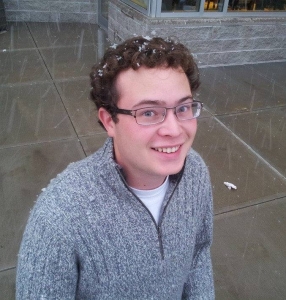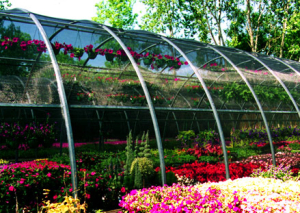Viridescent Beings
“Just as you can pick out the voice of a loved one in the tumult of a noisy room, or spot your child’s smile in a sea of faces, intimate connection allows recognition in an all-too-often anonymous world. This sense of connection arises from a special kind of discrimination, a search image that comes from a long time spent looking and listening. Intimacy gives us a different way of seeing, when visual acuity is not enough.”
–Robin Wall Kimmerer
“Harmony with land is like harmony with a friend; you cannot cherish his right hand and chop off his left.”
–Aldo Leopold

Terrance Caviness
Terrance is a junior at SUNY-ESF majoring in environmental biology and minoring in environmental writing and rhetoric, and Native Peoples issues and the environment. In the future he hopes to work in education outreach, teaching people about plants and the environment.
I took over the family greenhouse business three years ago. It has stood with the family for over fifty years, across the generations. Through marriages and divorces it has stood resolutely beside my family. Yet even though it supported us all these years, everyone but I was willing to leave it behind, to let it melt into the history of the land and our family. I decided to take care of it, as it has of us. My responsibility was not selfless though; I have come to love the land my greenhouse sits on; I know where to duck inside, where to dodge the puddles that form after watering its thirsty plants on a warm April morning, and where each plant prefers to sit. I know the plants that call the greenhouse home each year; I know their personalities, their likes and dislikes. Each spring it’s like welcoming back old friends, bringing them back home. I often go to the greenhouse–while it is loaded with a hundred shades of verdant leaves and bursts of red, pink, purple, and white–to think. There is a clarity that can be achieved there, in the silence, surrounded by beings that know their purpose in life; they have it figured out from the time of a seed. This gives me hope that one day I too will find my purpose in life. Being with the plants brings a clarity lacking in everyday life. To be there is to know there is more to life.
Once you know a space in its intimacy, love is sure to follow. Once a connection is formed with a piece of land, a park, a home, or an entire area, the love that develops will tie a piece of you to that place for your life. Everyone has a place where they go, or used to go that can be recounted with such vividness that the trees can be seen and the grass smelled. The love for a piece of land can come from many places, but the unifying factor is a deep connection of identity with it. Without that connection there is no love. How can you love what you fail to connect with?
My greenhouse has stood in the same footprint for over fifty years. For fifty years the land beneath has supported the protection and warmth it provides. Before the greenhouse, it knew the plow, the farmer ripping nutrients from its protective grasp of the soil to feed the corn. Still earlier it provided the native Onondaga people with sustenance. This one piece of land, just 2,000 square feet, has more stories than any person on earth. Today it supports my greenhouse; 100 years from now it might support a home, or a park, or a forest. I have known this land and the land around it my entire life: I can tell you about the magnolia tree in the front that has come back from the brink of death and flowers twice a year, or the family of ducks that come to nest in the small strip of woods near the greenhouse, or the tiny patch of three-inch powder-blue flowers rising up in the same spot in the woods each year that refuse to grow anywhere else. I can also tell stories of my family’s ties to it: how my great-grandfather built the greenhouse; how my grandmother spent the summers tending the vegetable gardens they put on the land; how even the land that surrounds the greenhouse is as much a part of the story of the greenhouse as the business itself. The old trees near the back perfectly shade the delicate leaves of the impatiens and elegant pendants of fuchsia, while in the front the geraniums bathe in steady streams of sunlight.
The plants have taught me more about themselves and the natural world around me than any person. Each has their own personality. The quiet and reserved impatiens are shy children hiding in the shadow of their mothers, late to reach their potential, but once they do are unmatched in their brilliant flowers perched on the ends of julaceous stems. Others share the classic elegance of the hanging fuchsia. Like a wise grandmother, comfortable with her age, they have stems swathed with flowers that dangle like the pendant jewels of an antique necklace. Still others are like the boisterous red geraniums stealing the attention, or the whimsical fuzzy ageratum whose flowers bury themselves in warm blankets of leaves. I see their personalities as evident as those of people; you just have to take the time to get to know them, to understand them. To know is to love.

Once the love of a piece of land is found, it is seen in a different light. It is no longer just a piece of property, it becomes a person in its own right, one to protect and care for. Once the land is seen, an even deeper connection with the land is reached: it is a friend, a companion. It isn’t just you taking care of the land, the relationship becomes reciprocal; the land returns the care. The garden is planted and weeded, and the land then provides a bountiful harvest. Love is given to the land, and the land returns that love. Once this exchange of love is seen it is impossible to ever think of the land as an inanimate object ever again. Instead it is being as alive as yourself, and capable of much more.
We humans often forget we are a part of the world; we are not separate from it. No organism is independent; each relies on another for survival. When I was younger I never cared much when people would talk about environmental issues. It wasn’t until I saw the land and all of its inhabitants as beings of importance in and of themselves that I began to care. This realization came when I was able to describe the plants with their unique personalities. Their worth is not determined by humans, worth is a human concept. When discussing conservation some people may ask “What does it do?” or “Why is it important?” but these aren’t the right questions. They should be asking, “Is what I want worth more than the existence of these beings?” Hopefully the answer is no. If it is not we begin to build a wall between us and the rest of the natural world. We must realize when you remove a piece from the web of life it is irreparable; it can never function in the same way again. When the land and the beings upon it are respected, the questions “What does it do?” or “Why is it important?” are irrelevant; they have a right to be on this earth as much as we do.
Through my respect for plants and the land, I have found my purpose. I am as sure as the seed that knows it will one day become a maple. I want to share the stories of plants with others, from their individual personalities to the way they interact with each other. I want others to realize what I have: that the well of life is fed by these awe-inspiring beings, that we are indebted to them, and they have stories to tell, and we must be open to hear them. Becoming part of nature is the first step to knowing. We are no more, nor less important to the world than the fine feathery wefts of moss that work tirelessly to form the soil for the graceful fronds of ferns and eventually the stalwart maples that will guard the forest yet to be created. We are neither more nor less important than the worms that enrich the soil, or the chipmunk that buries the acorn. We as humans have a role to play, and that is for each of us to find for ourselves, how each us can contribute to a world that gives so much.
